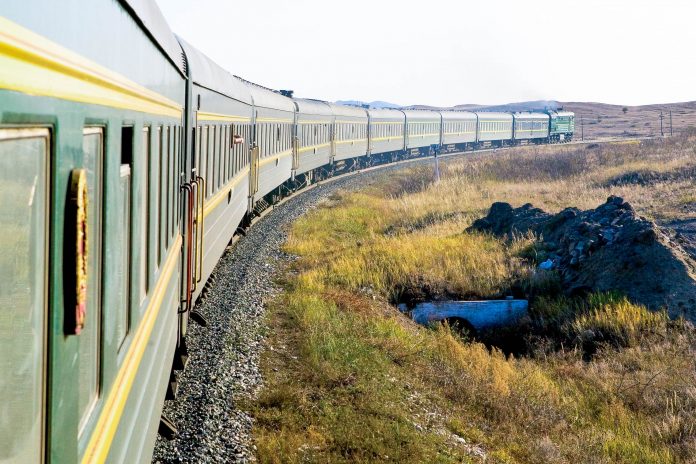Die Transsibirische Eisenbahn von Moskau nach Wladiwostok ist die längste Eisenbahnstrecke der Welt. Eine Fahrt mit dem legendären Zug bringt einem die wildromantische russische Taiga näher.
Die Transsibirische Eisenbahn ist die längste durchgehende Eisenbahnstrecke der Welt. Als Hauptverkehrsachse Russlands führt sie von der russischen Hauptstadt Moskau bis nach Wladiwostok im Südwesten Russlands am Japanischen Meer und weiter über die chinesische Grenze nach Pjöngjang und Peking. Die berühmte Bahnlinie zählt zu unseren Top 10 Sehenswürdigkeiten von Russland.
Inhaltsverzeichnis
Herausfordernder Bau der Transsibirischen Eisenbahn
Der symbolische Spatenstich zum Bau der gewaltigen Strecke erfolgte im Mai 1891. Durch den Bau der Eisenbahnverbindung erhoffte man sich in Russland wirtschaftlichen Aufschwung und weitere Exporte von Getreide bzw. eine lukrative Verkehrsverbindung von China nach Europa. Aufgrund der enormen Länge der Strecke wurde die Schienenlegung an mehreren Stellen gleichzeitig begonnen.
Der Bau gestaltete sich als äußerst schwierig. Schuld daran waren die tiefen Temperaturen bis zu -50°C, die den Boden bis in den Juni hinein frieren ließen sowie das unwegsame Gelände. An der Baikaltrasse mussten auf nur 260 Kilometern 200 Brücken und 30 Tunnel gebaut werden. 900.000 Arbeiter waren mit dem Bau beschäftigt. Durch mangelhafte medizinische Versorgung, fehlende sanitäre Einrichtungen, die eisige Kälte und Unfälle überlebten Zehntausende das Bauprojekt nicht.
Aus Kostengründen wurde die Qualität des Materials am unteren Limit des vertretbaren angesetzt, was um 1900 nach Tauwetter zu mehreren Entgleisungen führte. 1916 war der Bau der Transsib mit der Einweihung der Amurbrücke offiziell fertiggestellt. Der wirtschaftliche Aufschwung erfolgte tatsächlich in den nächsten 15 Jahren und auch die Zuwandererzahlen in Sibirien stiegen deutlich an.
Streckenführung der Transsib
Die Strecke, die die Transsibirische Eisenbahn zurücklegt, ist 9.288 Kilometer lang. Auf ihrem Weg von Moskau nach Wladiwostok hält sie an über 80 Stationen, passiert über 400 Bahnhöfe und überquert 16 große Flüsse.
An der Strecke liegen außerdem 89 russische Städte, darunter Nowgorod, Jekaterinburg, Omsa, Nowosibirsk, Krasnojarsk, Irkutsk, Ulan-Ude, Tschita und Chabarowsk. Auch die malerischen Ufer des Baikalsees und der Amurbucht im Japanischen Meer begleiten die Transsibirische Eisenbahn auf einer Länge von 207 bzw. 39 Kilometer.
Von der Transsib zweigen auch Routen nach China, Nordkorea und in die Mongolei ab. In Taischet kreuzt sich die Transsibirische Eisenbahn mit der Baikal-Amur-Magistrale (BAM), die nahezu parallel, jedoch etwas weiter nördlich verläuft. Sie wurde aus militärischen Gründen gebaut, da die Strecke der Transsib zu nahe an der chinesischen Grenze liegt. Betrieben wird die Transsibirische Eisenbahn von der russischen Bahngesellschaft RZD mit über einer Million an Mitarbeitern.
Tipp: Manche Züge verkehren nur wöchentlich oder jeden zweiten Tag und sind schnell ausgebucht. Ist die Reise daher einmal geplant, ist eine möglichst rasche Buchung zu empfehlen. Um die Reiseplanung möglichst einfach zu gestalten, beginnt man am besten beim Ankunftstag im Ankunftsort und plant rückwärts.
Unterwegs mit der Transsib
Jeden zweiten Tag macht sich ein Zug vom Jaroslawer Bahnhof aus auf die Reise von Moskau nach Wladiwostok. Die Waggons sind alle mit Liegen ausgestattet. Es gibt Zweier, Vierer oder Großraum-Abteile mit 52 Liegeplätzen. Sitzplätze gibt es nur tagsüber in den kurzen Zügen, die zwischen den einzelnen russischen Städten verkehren, zum Beispiel von Omsk nach Nowosibirsk.
Die heutige Strecke der Transsibirischen Eisenbahn wird seit den 1930er Jahren befahren und ist von wildromantischer Landschaft und einzigartigen Städten geprägt. Überwiegend zieht die russische Taiga an den Schiebefenstern der Waggons vorbei. Bei Kilometer 1.777 nach Moskau mitten im Ural markiert ein Obelisk die Kontinentalgrenze zwischen Europa und Asien.
Die Ankunft in Wladiwostok von Moskau aus erfolgt nach 144 Stunden Fahrtzeit, das sind genau 6 Tage. Zwischendurch werden immer wieder Pausen eingelegt, um die Züge auf ihrer mehrtägigen Reise zu überprüfen und die Loks auszutauschen, was allein schon wegen den unterschiedlichen Stromsystemen notwendig ist.
Tipp: In Russland gibt es keine Umsteigefahrkarten, dadurch beginnt im Prinzip nach jeder Fahrtunterbrechung eine neue Reise, was die unterbrochenen Fahrkarten um bis zu 61% teurer macht. Wenn möglich sollte also am besten gleich der durchgehende Zug gebucht werden.
Weiterführende Links:
Alle Infos zur transsibirischen Eisenbahn inkl. Ticket-Preise und Fahrpläne





